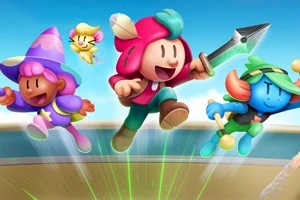Fire Flower #12: Are Sequels Equal?
Posted 19 Jul 2005 at 17:41 by guest

| "The defences go up and we cast a scornful eye over the game, wondering whether or not we should relax and enjoy ourselves." |
Sequels get quite a bad rap these days: there's a collected communal groan from all of us here at Cube-Europe when yet another FIFA game is spun out, or this year's "highly anticipated" follow on from last years "poorly received" Bond game. As Nintendo fans, there are those amongst us who are finding ourselves disenfranchised by the Mario franchise as it permeates almost every form of game media available on Nintendo consoles. However, the truth is that sequels sell.
In the Games Industry, much like in Hollywood, there are mixed feelings about sequels: sometimes they are nothing more than money-spinning clones of the original work with a sassy sidekick thrown into the mix to stir things up a little. Others are simple rehashes of the original piece that make use of advances in technology to make explosions that much bigger; or the CGI that much better. Rarely, however, does a sequel exceed the precedent of the original film or game by bettering the concept, the story or the characters.
So it is with great surprise and delight that we receive games such as Ratchet and Clank 2, Resident Evil 4 and Pro Evolution Soccer 3. It is so rare in the industry that we feel that real effort has gone into furthering the design and playability of the game that we are often quite wary of the sequel.
True, the sequel has familiar concepts and often an identical (but tweaked) interface; our suspicions are quickly raised at this point: our fingers have been burned before by empty continuations of our favourite licences. The defences go up and we cast a scornful eye over the game, wondering whether or not we should relax and enjoy ourselves.
However, it is the familiar that allows us to slip more easily into the game and learn it's new quirks; it's just like a nice fluffy pair of old slippers that have been custom-modded with nitro boosters and chrome plating. These same old ideas integrate the same old players into the unfamiliar aspects of the new game. For the new player, the older aspects of the game will not be known as familiar, but if they have been successful in past games, then they will have essentially the same effect of easing the new player into an old concept with a tried and tested method that has proven effective in its predecessor.
As for the newer ideas, they are often the natural evolution of concepts pioneered by the first game �or at least the game that was previous to the new title. Again, advances in technology may facilitate the expression and inclusion of new ideas, more often that not, however, newer concepts existed back in the original cycle of the previous title and were not included due to time constraints. Or perhaps the game was not expected to succeed and the addition of revolutionary or abstract content was considered to be too risky in an unproven title. It is the sequel, with its proven success and well-known title, that can afford to take a little risk and incorporate new ideas that may themselves become old ideas one day, and as a result the staple of the franchise.
Perhaps, however, things can go the other way: a successful game may receive the green light for a sequel and simply fail to deliver on the promise and power of the original by providing a game that is nothing more than the ideas and motions of the original on a slightly bigger scale. Let's use Halo 2 as an example. The original game was quite rightly the flagship title of Microsoft's console; it filled a rift in first-person shooters that had been left by the absence of a new Doom or Quake game of any note and by the successes of Perfect Dark and GoldenEye. It gave Xbox owners something to crow about in the workplace and playground. The sequel was hyped to be one of the most anticipated games of all time: you could ride the alien craft, you could be the aliens, you could wield TWO GUNS! Wow!
Then it arrived; and we realised that riding the alien craft was pretty boring, seeing as they all handled like milks floats or mopeds. The alien sections were interminably dull and long-winded with pointlessly 'atmospheric' sections of total darkness. And the dual-wield option revealed the frustrating limitation of only being able to carry two guns at once when every other shooter before had allowed a veritable arsenal to be carried in a small backpack.
Mario Sunshine is also a prime example of a sequel failing to deliver on expectations � and perhaps it's the expectations that are often to blame in these cases. Sunshine simply felt like 'Mario 64 1.5': there were very few new ideas implemented, the backpack was as much of an annoyance as an assistance and the same sort of levels and challenges could be found throughout all of the Mario games. Personally, I enjoyed it far more than Mario 64, but even I could see that when compared to its predecessor, it was not a bona fide sequel; just a jumble of half-baked ideas and a graphical showpiece for the console.
So there you have it; sequels can be good and sequels can be bad. Don't let the bland and uninspired blind you to the new and improved, otherwise you will deny yourself some of the finest games of this generation simply because of an unimportant number in the title.






















